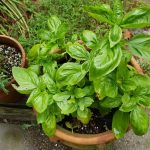Pumpkin spice is upon us. I know, the calendar says it’s fall, but I’m not done with the garden-fresh flavors of summer. Cinnamon, clove, and allspice from when the leaves fall on through the holidays – but not yet please!
 There are still plenty of tomatoes and corn at farmers markets. Zucchini and summer squash abound. Bushel baskets are overflowing with peppers and eggplant. Even the pots of tender herbs on my front steps are still flourishing, ready to boost the flavors.
There are still plenty of tomatoes and corn at farmers markets. Zucchini and summer squash abound. Bushel baskets are overflowing with peppers and eggplant. Even the pots of tender herbs on my front steps are still flourishing, ready to boost the flavors.
Yes, apples are pushing peaches off of the fruit display and robust pumpkins and colorful winter squash are making an appearance, but there’s plenty of time for them.
Soon enough, shorter days and a likely frost will put an end to the tender produce. But until then, I say, “hold off on the pumpkin spice.” There will be plenty of brisk weather for those warming flavors in the month’s ahead.
 Pesto’s garden freshness is one of the most flavorful ways to extend summer. This year, I’ve had a bumper crop of basil from two pots with a southern exposure. I’ve cut it back twice so far to make batches of pesto, and I’m hoping for a third crop to stock the freezer.
Pesto’s garden freshness is one of the most flavorful ways to extend summer. This year, I’ve had a bumper crop of basil from two pots with a southern exposure. I’ve cut it back twice so far to make batches of pesto, and I’m hoping for a third crop to stock the freezer.
Herbal pesto is one of those things that joins well with pasta, seafood, chicken and more. Last week I tossed some angel hair with roasted shrimp, cherry tomatoes and a generous dollop of pesto. It would work just as well with some sautéed chicken breast.
The other day, I was looking up recipes for braised halibut. I hadn’t thought about braising fish, a process that usually involves long, slow cooking of tough pieces of meat in a savory liquid. A delicious restaurant presentation got me interested in braised fish. It was tender, perfectly flaky and redolent of the braising liquid.
I found a recipe from the Williams Sonoma website that combined the braising with a farm-stand mix of late summer vegetables. Corn cut from the cob and sliced zucchini were gently simmered in the juice of a diced vine-ripened tomato. Once everything was bubbling, a couple of thick halibut filets were nestled in the mix, the temperature turned down and the pan covered. I added a smear of pesto on the fish for more flavor. Ten minutes later we had a delicious one-dish meal brimming with summer flavor.
Traditional pesto, originating from the region around Genoa, Italy, is a summery mix of fresh basil, pine nuts and garlic blended with olive oil and thickened with grated Parmesan cheese. It’s a natural partner with tomatoes and adds zest to almost anything. Potato or pasta salad, for instance, get a new lease on life with added pesto. Put a dab on grilled bread and top with cheese for a delicious bruschetta.
There are, of course, variations to incorporate other flavors or replace out-of-season or hard to find ingredients. Almost any nut can be swapped for the pine nuts. Toasting them first enhances flavor.
Other leafy herbs like mint, parsley or cilantro can be added to the mix. To jump start the pesto season, use the early-spring wild ramps to make a batch. Leafy greens like spinach or arugula can be pureed into a pesto too. Further south in Italy, they sometimes add roasted peppers.
Pesto became popular in the 1980s and 90s. It can be found in cuisines around the world, adapted with local flavors into regional dishes.
Creative chefs have gone even farther afield, broadening the idea of pesto with grape tomatoes and ricotta to dress vegetables or a mix of fennel and dried figs to spread on crostini.
Before too long, I’ll be craving pumpkin spice in a slice of pie, but as long as the farm stand produce lasts and there’s still some pesto in my larder, I’m hanging onto summer.
Frank Whitman can be reached at NotBreadAloneFW@gmail.com.












No Comment